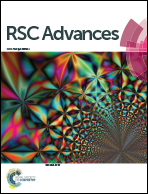Repeat protein mediated synthesis of gold nanoparticles: effect of protein shape on the morphological and optical properties†
Abstract
Repeat proteins have recently emerged as promising candidates for the modular design of biohybrid platforms with a high degree of tunability. Consensus sequence tetratricopetide repeat (CTPR) proteins with increasing number of repeats were designed to probe the effects of protein shape on the morphology and resulting physicochemical properties of plasmonic gold nanoparticles. In a synthetic procedure analogous to the biomineralization processes in nature, CTPRs with 3, 6, or 18 tandem repeats were used as both the stabilizing and shape-directing agent. The electronic microscopy and spectroscopic studies indicate that both the [HAuCl4]/[CTPR] ratio and the CTPR shape have dramatic implications on the morphology and plasmon absorbance of the as-synthesized Au NPs. Induced plasmon ellipticity and fluorescence quenching data provide further evidence for the molecular interaction between CTPR and Au NPs or HAuCl4 species. Overall, this work elucidated the effects of CTPR protein shape on the morphology and plasmonic properties of Au NPs, which will further guide the rational design of modular protein based bioconjugate frameworks for colorimetric and enantiomeric biosensors.


 Please wait while we load your content...
Please wait while we load your content...